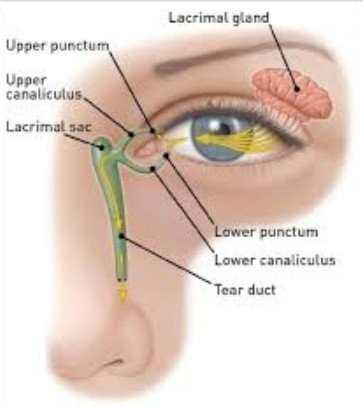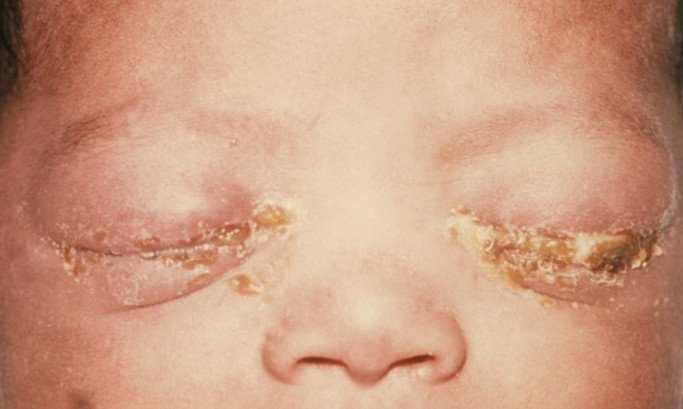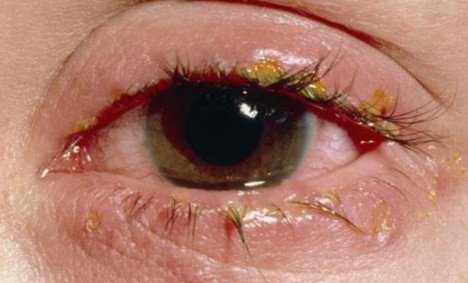Crusty eyes, especially in the morning, are common in both adults and babies (newborns). Crusty eyes in the morning are often from eye discharge that builds up and dries out overnight when one is sound asleep. We recommend your doctor if it is accompanied by symptoms such as:
- Vision changes
- Pain and
- Redness in eye
This article provides an insight into what cause these symptoms in both adult and toddles and how to treat it. We have also provided you with a guide on how you can get relief for crusty in your eye at home.
What causes crusty eyes?
According to the American Academy of Ophthalmology, crusty eyelashes or eyelid occurs when discharge from the eyes dries on the lids and lashes of the eyes. This is common and, as mentioned, can occur in both children and grownups.
Persistent crustiness in the eyes can signal an underlying eye infection, which might include any of the following conditions.
1. Pink eye or conjunctivitis
Conjunctivitis is an inflammation of the conjunctiva, the thin membrane that lines the sclera or whites f eyes. This condition is often accompanied by white, yellow, or green eye mucus that forms a crust along the lashes while asleep. Conjunctivitis is also known to cause itchy irritated eyes.
2. Bacterial and viral infection in the eye
Bacterial and viral infection in the eye can result in abnormal eye discharge, which can then result in crusty, dry, or watery eyes.
Common such infections include eye herpes, fungal keratitis, and Acanthamoeba keratitis caused by poor contact lenses hygiene. Others include viral and bacterial conjunctivitis.
3. Allergies
Allergic conjunctivitis triggered by dust, wind, pollen, and other irritants might, such as makeup, contact lenses, and eye drops. Unlike bacterial and viral conjunctivitis causing the crusty eye, allergic conjunctivitis is not contagious. It also affects both eyes.
4. Blepharitis

Blepharitis is a common cause of crusty eyes. It describes an inflammation of the eyelash follicles or abnormal production of oil from the Meibomian glands.
5. Blocked tear ducts
A blocked tear duct occurs when the eye’s drainage system for tears is either partially or completely obstructed. Tears fail to drain normally, causing watery, irritated, and sometimes infected eyes.
Tears come from the lacrimal glands that are located above each eye. Thy flows down to the eye to lubricate and protect your eyes; it then drains into tiny holes in the corners of upper and lower eyelids. When these ducts are blocked, it could cause crusting.
6. Chronic eye dryness
Chronic dryness caused by insufficient tear production or a dysfunctional Meibomian gland can cause irritation and inflammation of the eyes that could lead to crusting.
It can be shown by the following symptoms:
- Red bloodshot eyes
- Itching and burning sensation in eyes
- Blurry vision
7. Meibomian glands dysfunction
Abnormal eye discharge can also be caused by Meibomian gland dysfunction. This can be shown by foamy eye discharge, crusting eyelids, and yellow or green pus on eyes, among other painful symptoms.
Crusty eyes in newborns
Crusty eyes, as said, can occur in both children and adults. Depending on what the underlying cause is, it can occur in one or both eyes. In newborns, a common cause of this condition is that the tear drain system has not developed fully. Statistics show that this occurs in about 5% of newborns, with the majority said to outgrow this.
The crusty eyes in the morning and when occurring after sleep can also be a sign of other eye conditions which include the following:
1. Chalazion
This is a lump or cyst that forms on the eyelid. It starts off a small pimple-like bump then grows into a large bump. The bump is not contagious or painful, but it can cause your baby to have teary eyes. It could also distort vision by applying pressure to the eyeball.
To get rid of the bump, your doctor might advise you to apply a warm compress around it. This works by softening it and encouraging it to drain.
2. Sty
A sty (stye) is a red bump that develops on your child’s eyelid. It is caused by a bacterial infection of the eyelids. It will often appear as red and tender as it is filled with pus. With this bump, it is common to observe white or yellow discharge. This might make your eyes crusty.
It is not serious, but we recommend you treat it as soon as possible before it turns into a serious infection that is very unbearable for your baby.

3. Periorbital cellulitis
Periorbital cellulitis is a serious eye infection in toddlers that affects the tissues around your eyes. It affects only one eye, causing redness and swelling. It is caused by bacterial infection with other symptoms, including high body temperature, pink eye, and running nose.
Your pediatrician will prescribe antibiotic eye drops or an injection depending on the severity of the infection.
4. Sinus infection
Green eye discharge and crusty eyes n newborns during a cold might be a sign of sinus infection. In such a case, it will be accompanied by symptoms such as fever, congestion, and sinus pain.
In cases of these infections, you can use a warm damp cloth to get rid of the crust. Fever medication may be used to reduce the high fever your baby might be having. We recommend you visit a pediatrician as soon as possible.
Crusty eyes in the morning
Crusty eyes in the morning, as mentioned, is a common condition. It can occur in both adults and children. For children, if the crust seems to persist, it is a good idea you see your health care provider as soon as possible. Any symptoms regarding the eye should be taken very seriously.
In the morning, crusty eyes are often as a result of eye discharge that accumulates and subsequently dries out overnight. For a healthy person, there is a considerable amount of tears that your eyes produce to lubricate the eyes.
Crustiness in the eyes can be increased by different eye conditions that cause increased eye discharge. Conjunctivitis, which is an inflammation of the conjunctiva caused by either bacterial or viral infection, can increase eye discharge, which increases crustiness in the morning. In most cases, this will only affect one eye.
The other common cause of crustiness is allergic reactions. This may affect both eyes and often occurs when your eyes come into contact with substances like detergents or pillow fillings during the night. The reaction will often be accompanied by other symptoms such as running nose and coughing.
Red and Dry crust eyes
Red or dry crusty eyes are often signs of a possible eye infection. Depending on what the cause of the crusting is, one can also show the following symptoms:
- Blurry vision
- Itchy crusty eyelids and eyelashes
- Painful sore around eyes
- Watery eyes
- Bloodshot eyes
- Increased sensitivity to light and
- A burning sensation in the eye
Most of the above symptoms tend to clear on their own within an hour or two after you wake in the morning. If the symptoms, however, persist for a day, we recommend you have it checked out as soon as possible to avoid any complications.
Normal vs. abnormal eye discharge
Minor cases of crusty eyes are often considered normal. In such cases, they are not a cause for concern. Crusting can be considered abnormal and a cause for concern when the discharge starts to turn green or yellow. This can be followed by additional symptoms such as eye pain, blurry vision, and increased sensitivity to light.
One of the most common reasons for abnormal eye discharge is conjunctivitis. This condition makes it hard to blink and causes your eye to be encrusted. It also makes your eyes red (bloodshot). Conjunctivitis is very contagious and can spread through close physical contact. Antibiotics are used to treat bacterial conjunctivitis.
Inflammation of the eyelids (blepharitis) is also a possible cause of abnormal eye discharge that might be causing the crusting.
The other possible cause of abnormal discharge, especially in children, is a sty on eyelash. These bumps are formed when the hair follicles on your eyelash become infected. The eyelash becomes red and inflamed and could produce pus that can cause the crusting.
Crusty eyes complications

If untreated, depending on what the underlying cause of the crustiness is, some people might end up with the following complications:
- Blurry vision
- Permanent loss of vision
- When the cause is a viral or bacterial infection, then it might spread to other parts of the body
- Crusty eyelids caused by chronic dryness can result in permanent damage to the cornea
- Eye allergies might result in dry, and itchy eyes
- Redness in eyes or bloodshot eye
- In children, eye crusts might make it hard to open the eyes in the morning
Treatment
Crusty eyes caused by eye discharge are considered normal. However, if the discharge causing the crusts changes in frequency, color consistency, and amount, you need to have your primary healthcare provider check it out as soon as possible.
If the discharge is sound to be caused by an underlying eye infection, then treating the condition will often vary depending on what the underlying infection is. Most of these options are discussed above under each cause.
Crusty eyes relief
Chronic crusty eyes in both adults and children require proper medical attention to prevent some of the complications listed above. There are, however, some simple self-care methods one can use to offer relief for some of the symptoms accompanying the crusting.
A home, the following will help soothe the symptoms and get rid of crusty eyes:
1. Warm compress
A warm compress work in two ways. One, it increases the rate of blood flow to the affected area, thus speeding up the healing of the underlying infection that might be causing the dry, red, or itchy crust in the eye.
The other way is that it softens the crusts on eyelids and eyelashes, making it easier for you to get rid of them. All you need to use a clean cotton towel to gently apply a warm compress around the affected eye. A warm compress can help unglue sticky eyelids.
We highly recommend Microwavable Compress Pad with Storage Pouch for Dry Eyes (Check price on Amazon)
2. Stop using makeup
If the cause of the condition is an eye infection such as blepharitis, it will be a good idea to stop applying makeup until the condition is the tread. Applying makeup might only worsen the condition, given that your eyes might be allergic to some of the chemical ingredients used.
3. Apple cider
Apple cider vinegar if the other great and effective remedy you can use to get rid of the crust. This remedy contains malic acid that can kill bacteria, causing eye infection as well as soften the crust in your eyelids and eyelashes.
- Use a clean cotton ball to apply apple cider solution on your eyelids while your eyes are closed.
- Leave it on for a minute or two, then rinse it off with cold water.
- You need to do this every morning you wake up with crusty eyes.
4. Wash the crusts off with a salty solution
Washing your eyes with a salty solution can also help get rid of the crusts. Kitchen salt is said to be a natural antiseptic; thus, it can help prevent the spread of bacterial and viral infection from your eyes to other parts of the body.
- Add a tablespoon of kitchen salt in warm water in a basin.
- Gently mix to dissolve all the salt.
- Use the resulting solution to carefully wash your eyelashes and eyelids.
- Do not let the solution enter into your eyes.
- You can then rinse your face with cold water.
5. Green tea bag
Holding a wet warm green tea bag on your eyes can also help get rid of the dry, red crust on eyelids and eyelashes. This remedy is said to contain antioxidants such as tannic acid that kill microorganisms, causing infections.
A simple compress with a cold or warm green tea bag will also help relieve itching and reduce redness in the eyes.
References:
- Baby eye infections, types, symptoms, and treatment: http://www.newkidscenter.com/Baby-Eye-Infection.html
- Eye discharge, where does eye mucus come from http://www.allaboutvision.com/conditions/eye-discharge.htm
- Crusty eyelids or eyelashes: https://www.aao.org/eye-health/symptoms/eyelash-crusting
- Crusty eyes, causes, complications, and treatment: https://www.theralife.com/crusty-eyes/
- Are your eyes crusty or wet? The truth behind eye booger: https://www.nbcnews.com/health/body-odd/are-yours-crusty-or-wet-truth-behind-eye-boogers-ew-f1C6437167

